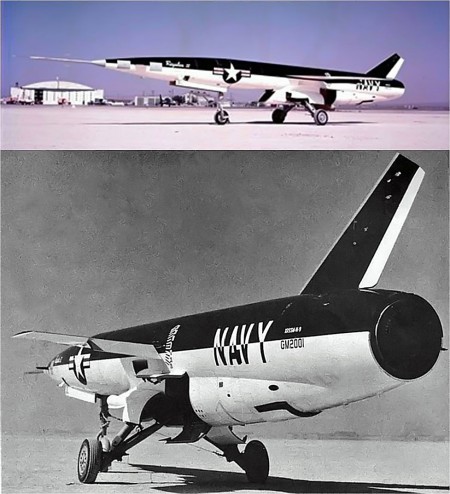Fifty-seven years ago this week, the United States Navy successfully conducted the first flight test of the Chance Vought Regulus II cruise missile. This initial test departed from and recovered to Rogers Dry Lake at Edwards Air Force Base, California.
The Regulus II was designed as the supersonic follow-on to the Navy’s Regulus I ship-launched cruise missile. Utilizing an inertial reference system, the Regulus II was autonomously guided to the target. This represented a great improvement over Regulus I which employed a more primitive radio command guidance system.
Like its Regulus I forebear, Regulus II featured an airplane-like external airframe configuration and cruised under turbojet power. The vehicle was rocket-launched to the turbojet takeover speed (300 knots) using the Zero-Length Launch (ZLL) concept. The single rocket booster generated 115,000 lbs of thrust for 4 seconds and was jettisoned following burnout.
The Regulus II missile engineering and development effort saw the missile built in three (3) airframe blocks. The flight test version was designated as XRSSM-N-9 and included seven (7) airframes (GM-2001 to GM-2007). The fleet training variant was designated as XRSSM-N-9A, of which twenty-nine (29) were built (GM-2008 to GM-2036).
The Regulus II tactical missile, designated XSSM-N-9, included thirty-eight (38) airframes (GM-3001 to GM-3038). It measured 67 feet in length and featured a wingspan of 20.75 feet. Gross Take-Off Weight (GTOW) and empty weight were 21,300 lbs and 11,690 lbs, respectively. Power was provided by a General Electric J79 afterburing turbojet.
As originally designed, Regulus II was intended to cruise 1,000 nm at Mach 0.94 and an altitude of 32,000 feet. This range fell to 600 nm at a cruise altitude of 5,000 feet. For a supersonic cruise at Mach 2 and 65,000 feet, the vehicle had design range of 635 nm.
Initial flight testing of the Regulus II missile did not use the rocket booster. Rather, the vehicle became airborne via a normal runway take-off. The missile was remotely controlled by a pilot flying alongside in a two-place control aircraft. In this case, the aircraft was a TV-2D; a modified version of the Lockheed T-33. The front-seater flew the Regulus II while the back-seater flew the control airplane. Chase support was provided by Douglas F4D Skyray and Vought F8U Crusader aircraft.
Airframe GM-2001 made the first test flight of a Regulus II vehicle at Edwards Air Force Base, California on Tuesday, 29 May 1956. The first XRSSM-N-9 departed Rogers Dry Lake at 14:11 UTC following a take-off roll of slightly over 12,000 feet. The missile quickly accelerated to 356 knots as it climbed to an altitude of nearly 11,000 feet. Amazingly, all major missile systems performed nominally during the nearly 33-minute test hop and GM-2001 landed safely back on the dry lake bed.
The Navy would go on to conduct forty-seven (47) more Regulus II flight tests through November 1958. These tests were successful in the main and the Regulus II system performed well overall. However, the emergence of the contemporaneous and superior UGM-27 Polaris Submarine-Launched Ballistic Missile (SLBM) rendered the Regulus II missile obsolete. As a result, the Navy cancelled the Regulus II Program in December 1958.

